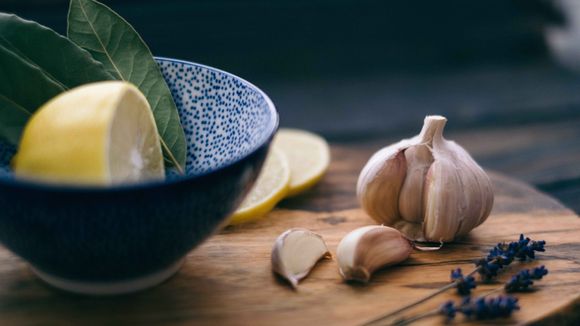Natural remedies
Tea Tree Oil (Melaleuca alternifolia)
Tea tree oil, derived from the leaves of the Australian tea tree (Melaleuca alternifolia), has been used for centuries as a natural antifungal and antibacterial agent. Its effectiveness against various fungal infections, including tinea cruris, has been well-documented in scientific research (1).
Recipe
Mix a few drops of tea tree oil with a carrier oil like coconut oil or almond oil, and apply the mixture to the affected area twice a day until the infection clears.
Garlic (Allium sativum)
Garlic, a culinary staple, has powerful antifungal properties that can help combat jock itch. Allium sativum is the Latin name for this plant, which is native to Central Asia and northeastern Iran. Its active compound, allicin, has been shown to be effective against various fungal infections, including tinea cruris (2).
Recipe
Crush a few garlic cloves and mix them with olive oil to form a paste. Apply this paste to the affected area and leave it on for 30 minutes before rinsing with warm water. Repeat daily until the infection clears.

Photo by Alexander Lyubavin on Unsplash
Aloe vera (Aloe barbadensis)
Aloe vera, a succulent plant native to the Arabian Peninsula, has been used for centuries to treat various skin conditions, including fungal infections. The gel from Aloe barbadensis leaves has been shown to have antifungal properties, making it an effective treatment for jock itch (3).
Recipe
Extract the gel from an aloe vera leaf and apply it directly to the affected area. Allow it to dry before rinsing with warm water. Repeat this process twice a day until the infection clears.
Neem (Azadirachta indica)
Neem, also known as Indian lilac, is a tree native to the Indian subcontinent. Its leaves, bark, and seeds have been used in traditional medicine to treat various skin conditions, including fungal infections. Studies have shown that neem extracts possess potent antifungal properties, which can help treat tinea cruris (4).
Recipe
Boil a handful of neem leaves in water, strain the liquid, and let it cool. Use this solution to wash the affected area daily until the infection clears.

Photo by Jac Alexandru on Unsplash
Questions and Answers
Q: Can I use these remedies if I have sensitive skin?
A: If you have sensitive skin, it is advisable to perform a patch test before applying any of these remedies to the affected area. Apply a small amount of the remedy to a discreet spot on your skin and wait for 24 hours to check for any adverse reactions. If there is no reaction, you may proceed with using the remedy. If you experience any irritation, discontinue use and consult with a healthcare professional.
Q: How long does it take for these remedies to work?
A: The duration of treatment varies depending on the severity of the infection and the individual's response to the remedy. It is essential to be consistent with the chosen treatment and follow the recommended application frequency. Most people start noticing improvements within a week or two, but complete healing may take several weeks.
Q: Can these remedies be combined for better results?
A: Some of these remedies may be used together, such as using aloe vera gel to soothe the skin after applying garlic or tea tree oil. However, it is essential to consult with a healthcare professional before combining multiple treatments to ensure safety and prevent any potential adverse effects.
Q: Are there any precautions I should take while using these remedies?
A: Always follow the recommended usage instructions and consult with a healthcare professional before starting any new treatment. Be cautious if you have allergies or are taking medications that may interact with these remedies. Additionally, maintain proper hygiene, wear loose-fitting, breathable clothing, and avoid sharing personal items like towels to prevent the spread of the infection.
Referrals
- Carson, C. F., Hammer, K. A., & Riley, T. V. (2006). Melaleuca alternifolia (Tea Tree) oil: a review of antimicrobial and other medicinal properties. Clinical microbiology reviews, 19(1), 50-62.
- Shams-Ghahfarokhi, M., Shokoohamiri, M. R., Amirrajab, N., Moghadasi, B., Ghajari, A., Zeini, F., ... & Razzaghi-Abyaneh, M. (2006). In vitro antifungal activities of Allium cepa, Allium sativum and ketoconazole against some pathogenic yeasts and dermatophytes. Fitoterapia, 77(4), 321-323.
- Vázquez, B., Avila, G., Segura, D., & Escalante, B. (1996). Antiinflammatory activity of extracts from Aloe vera gel. Journal of Ethnopharmacology, 55(1), 69-75.
- Pandey, A. K., & Singh, P. (2017). The Genus Azadirachta (Meliaceae): An Ethnopharmacological, Phytochemical, and Pharmacological Review. Natural Product Communications, 12(11), 1934578X1701201129.









